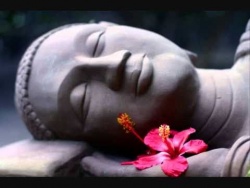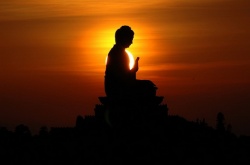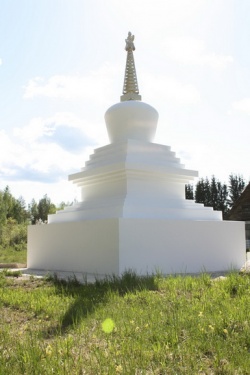What Is Dzogchen?
Dr. Alexander Berzin
Dzogchen might have a reputation for being effortless, but in order to practice it properly in the first place, we need to put in tremendous effort to understand what are known as the outer and inner preliminaries. With perseverance and wisdom, dzogchen becomes an incredibly profound and effective method for achieving enlightenment for the benefit of all beings.
Dzogchen is a very advanced system of meditation on the deepest, subtlest, foundational levels of mind. “Mind” refers to the unbroken mental activity of cognitively engaging with objects, described from another point of view as the mental activity of giving rise to appearances (mental holograms).
The term “dzogchen” means “great completeness,” referring to the fact that all the qualities of Buddhahood are complete on the level of rigpa (pure awareness), the deepest foundational level of them all. Although nothing needs to be added to what’s called beginningless and endless “basis rigpa,” nevertheless, these qualities aren’t functioning now at their full capacity. Why? Because the obscuring factor of dumbfoundedness (bedazzlement) has been simultaneously arising with it, also without beginning.
“Dumbfoundedness” is an automatically arising unawareness of the void (empty) nature of all phenomena – the total absence of impossible ways of existing. It obscures rigpa’s so-called “reflexive awareness” of it own pure nature. This pure nature is threefold:
Primal purity – It is devoid of all grosser levels of cognition (limited awareness, “sem”) at which conceptual cognition, disturbing emotions and even ordinary sense perception occur. It is also primally pure of all impossible ways of existing.
Spontaneously establishing – It gives rise to all appearances (mental holograms).
Responsiveness – It emanates out in response to causes, conditions and the needs of others. In a sense, it “communicates” compassionately with those needs.
This threefold nature is responsible for our faculties of mind, body and speech respectively.
When basis rigpa is flowing together with this fleeting factor of dumbfoundedness, basis rigpa is functioning as an alaya for habits – foundational awareness, on which are imputed:
Memories
Karmic potentials and tendencies
Tendencies for the disturbing emotions and nominal disturbing attitudes
Habits of grasping for impossible ways of existing.
The aim of dzogchen meditation is to attain (1) a true stopping of dumbfoundedness and thereby a true stopping of the alaya for habits and (2) the complete functioning of all the innate good qualities of rigpa in order to be of fullest benefit to all beings.
Dzogchen is taught in the Nyingma and Bon traditions in Tibet, and was later incorporated into the various Kagyu schools as well. In the Nyingma classification system of nine vehicles of mind, it is known as atiyoga: the highest of the six tantra vehicles. Nowadays, however, dzogchen-style meditation is frequently taught outside its sutra and tantra contexts – for instance, as a method for calming the mind and attaining the perfect concentration of shamatha (a stilled and settled state of mind). As such, it can be very effective. Nevertheless, for attaining liberation and enlightenment, dzogchen practice is only undertaken on the basis of extensive study and practice of:
The outer preliminaries – the precious human life, impermanence, the sufferings of samsara, karmic cause and effect (ethics), the benefits of liberation (renunciation), and a healthy relation with a qualified spiritual teacher
The inner preliminaries – refuge (safe direction) together with prostration, bodhichitta based on love and compassion, Vajrasattva purification, mandala offering, chod offering of one’s body, and guru-yoga.
After completion of all that, it is necessary to receive tantric empowerment (initiation) and strictly keep all the vows we take. On that basis, further required are:
Mahayoga tantra practice – deity-yoga with Buddha-figures and mantras
Anuyoga tantra practice – work with the subtle winds, channels, and energy-drops.
Without a strong build-up of positive force (merit) and deep awareness from all these practices and the inspiration and close guidance of a qualified master, it is not possible to achieve success in dzogchen practice; it is simply too subtle and difficult to do.
Without any preconceptions, expectations or worries, dzogchen meditation begins by quieting our mental activity down to the space between verbal conceptual thoughts of “this” and “that.” Each moment and each verbal syllable of each such thought simultaneously arises, abides and ceases. We can only properly identify this if we have studied and meditated beforehand on the Madhyamaka presentation of the voidness (emptiness) of arising, abiding and ceasing and the total absence of a findable “me” controlling or observing the process. By maintaining mindfulness of this simultaneous arising, abiding and ceasing, there is no need for conscious effort: verbal conceptual thought automatically “liberates itself” – meaning that it disappears by itself – and we settle into the state between thoughts.
Next, we need to distinguish the simultaneous arising, abiding and ceasing of the microseconds of our non-conceptual sensory cognition. During such microseconds – incredibly difficult to distinguish – we perceive merely the sensory information of just one sense faculty (for instance, mere colored shapes) prior to conceptually synthesizing it with information from the other senses and with information from further microseconds and designating that mental synthesis as “this” or “that” conventional object. When we are able to settle into the level of mental activity in between even those microseconds, we have accessed the alaya for habits. This is still a type of limited awareness, however, because it is still mixed with the factor of dumbfoundedness.
We need to go deeper and subtler, so that we experience and recognize the cognitive in-between space that has deep awareness of its own threefold nature (primal purity, spontaneously establishing and responsiveness). We do this with the help of our dzogchen master employing special methods enabling us to recognize the nature of our mind. Because of having “greased” the pathways of our energy-channels with previous anuyoga practice, all grosser levels of mental activity automatically dissolve without conscious effort to make that happen.
With the ceasing of dumbfoundedness, our alaya for habits becomes effulgent rigpa – that is, rigpa in its aspect of actively giving rise to cognitive appearances (mental holograms) and actively cognizing them, with the former more prominent. But we need to go even deeper than that. Staying focused with the simultaneously arising, abiding, and ceasing of microseconds of the pure appearances of effulgent rigpa, we need to recognize essence rigpa. This is rigpa in its aspect of being the “open space” or “cognitive sphere” that allows for the arising of appearances and the cognizing of them, with the latter more prominent. When we recognize and stay focused with this, we attain break-through, a seeing path of mind (path of seeing), the third of the five pathway minds on the way to enlightenment.
Then, as the result of practice with Buddha-figures in mahayoga, effulgent rigpa gives rise to and cognizes itself as a rainbow body, rather than with ordinary aggregates. Thus, on the leap-ahead stage – equivalent to an accustoming pathway mind (path of meditation) – through four stages, effulgent rigpa becomes more prominent while simultaneously maintaining prominent essence rigpa. When effulgent and essence rigpa become equally prominent, we attain enlightenment and, as the result of our intense love, compassion and bodhichitta aim, maintained throughout this practice, we are enabled to benefit all beings to the fullest extent possible.
Summary
Dzogchen has the reputation of being a direct, effortless path of just settling into mind’s natural state. Although it is true that just by recognizing what is happening in our cognitive experience, conceptual thoughts and all other levels of limited awareness cease and our minds give rise to our pure appearance with all the complete faculties of a Buddha, none of that can possibly happen unless we have put in a tremendous amount of effort in this and previous lives on all the sutra and tantra preliminaries. We must not be naive and underestimate the difficulty of dzogchen practice. With sufficient preparation, however, it is one of the most profound methods for attaining enlightenment for the benefit of all.
Source
https://studybuddhism.com/en/tibetan-buddhism/tantra/mahamudra-dzogchen/what-is-dzogchen




